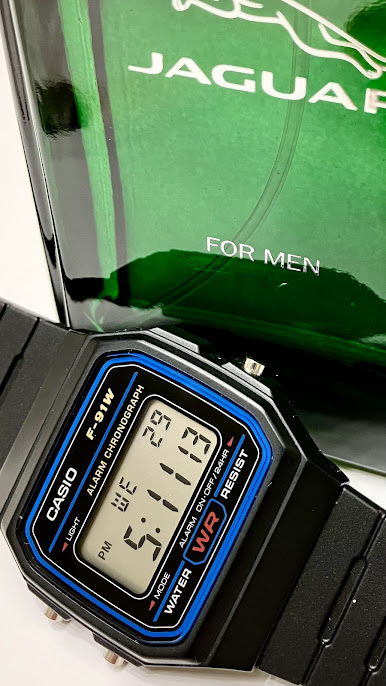Jaguar for Men is one of those frags that falls prey to reformulation anxiety, the fear that grips dyed-in-the-wool fragrance fanatics whenever they get their hands on something they've never smelled before. Crafted in 1988 by Thierry Wasser, now of Guerlain, the first version was apparently a musky-woody powerhouse in true '80s fashion. Then the '90s came a-knockin, and at some point in the ensuing decade a perfumer from Mane named Dominique Preyssas reformulated it and stripped out the musky bits, which resulted in something a few ticks closer to the original Polo from '78. I've never smelled either of those formulas; my first experience with Jaguar is from a 2021 bottle manufactured by Lalique Beauty, via a post-Preyssas formula that smells nothing at all like Polo (you can keep Polo) and a heck of a lot like the original Krizia Uomo (thank God).
Well, three parts Krizia Uomo, that is, and one part Sir Irisch Moos, that neon-green stuff from Germany in the little geometric bottle that is all but impossible to find in America nowadays. At this point it's safe to say that the only entity one can truly attribute this fragrance to is the manufacturer, Givaudan, which has supplied the majority of Lalique's perfumes for many years now. Preyssas's formula likely survived the years with minor focus-grouped tweaks here and there. I find it interesting that it smells so dimensional and well made for something so out of fashion (not cheapened), and even more intriguing that it so closely resembles a revered discontinued gem like Krizia Uomo. Why is nobody talking about this? Ever since Krizia went bye-bye, its many fans have been gnashing their teeth, needless given that Jaguar exists. The rich cedar and mossy-resinous textures of the Italian scent are here as well, only Lalique's fragrance is brighter, spicier, with a woody orange citrus note that dominates the profile, something Uomo never had.
There's a bit more vintage Irish Spring Soap to Jaguar, something fresher and more forward-leaning in its style that has me feeling glad I took the plunge on it. The problem with owning this is that I wonder when I'll ever wear it -- my girlfriend dislikes these old earthy masculines, and I don't really blame her. I can imagine what it must be like to spend a few hours around the guy who sprays this one time too many. But then again, there's no denying Jaguar smells fantastic. I don't care that the '80s are over. You know what's never over? Smelling crisp and clean. This isn't a Millennial aquatic or ozonic "blue" thing. This isn't your brother's bottle of Fierce. This won't get you laid on Saturday night. This is the sort of thing you spray on to fight the invading Turks. Masculine, virile, rich, clean, a little heroic, the box and bottle even come in Sherwood Green. Simply perfect.








